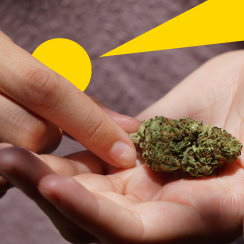THC percentage can be a handy, easy-to-find tool for speedy flower shopping. But it’s not the only way to get the weed you want. In fact, it may not even be the best way.
Dig a lil’ deeper with our budtender pals at Insa, Health Circle, + South Shore Buds to discover other paths to products that spark smiles or an appetite, ease pain or stress, + inspire a good time or a good night’s rest.
1. Explore terpenes (follow your nose)
Terpenes determine how weed smells + tastes, but also how it hits. Their interaction with different cannabinoids gives strains their individual effects, so you can *literally* follow your nose to the feeling you’re looking for.
DJ, Health Circle: Learn which terpenes work for you. It’s not always about the THC percentage. Some bodies react to different terpenes better than others. Definitely find the ones that do it best for you.
Science is just scratching the surface of terpenes + their ability to help with everything from pain, stress, + focus to potentially treating serious ailments.
Here are just a few of the many well-established benefits to some of the most common terpenes:
- Myrcene – Myrcene has a musky, earthy aroma + is one of the most frequently-found terpenes in weed. It tends to induce a sedative, couch-lock effect + has been shown to relieve pain + inflammation.
- Linalool – This terpene’s scent is usually compared to lavender, so it makes sense that it can ease anxiety + tension. Linalool is commonly used as a mood booster, sleep aid, + tool for combating nausea or lack of appetite.
- Pinene – Just like its name says, pinene has a sharp pine scent. This dynamic terpene may ease inflammation, has respiratory benefits, + is even being studied as a focus aid.
- Caryophyllene – Caryophyllene is behind the sharp scents of hops, black pepper, + cinnamon. According to early research, this terpene may boost metabolism, reduce inflammation, + improve blood flow.
Abbie, Insa Salem: I love learning more about terpenes to help find specific strains for people’s needs. I prefer myrcene for relaxation.
Check out other terpene types likely to pop up on the label, like limonene, geraniol, ocimene, humulene, + terpinolene.
2. Balance your THC + CBD ratio
CBD (along with THC) is one of many cannabinoids found in weed. CBD alone doesn’t get you high, but its interaction with THC influences the effects you feel. Depending on the ratio to THC, CBD may cause calm + grounded vibes, relief from aches + pain, or even an easing experience entirely free from any high.
Tell your budtender what you want out of your weed + they should be able to direct you to the perfect high-CBD product. They can also help you find the best THC:CBD ratio so you’ll be in a clear headspace while reaping all the benefits you need.
Brooke, South Shore Buds: When choosing a product, I would recommend to first determine what feeling or relief you are trying to achieve. Ask questions such as, are you trying to gain relief from something, i.e., anxiety, insomnia, lack of appetite, etc.
3. Consider other influential cannabinoids
The world of cannabinoids runs far beyond THC + CBD. But it’s all too easy to get lost in a swarm of acronyms, especially when you don’t know which matter the most. Here’s what to focus for better insight into how a strain may interact with your body.
- Cannabinol (CBN) – A psychoactive cannabinoid that is born from old, degraded THC. CBN shares some of the effects of THC, but its most effective use is for sleep. Though still rare, CBN isolate can be found in some shops, sold as a sleep aid.
- Tetrahydrocannabinol (D9-THC) – More commonly referred to as THC, this is the most abundant and widely-known cannabinoid because it’s the one most responsible for determining the intensity of your high.
- Total Active Cannabinoids (TAC) – TAC is represented as a percentage, often found at the top of the label. This number includes THC, CBD, and any other cannabinoids that may be present. Each cannabinoid has a unique therapeutic value, so strains with more cannabinoids that stretch far beyond THC and CBD tend to be far more multifaceted, offering a diverse high.
Daisy, Health Circle: If you’re looking for a daytime product, try to find items with THCV – it’s super uplifting and motivating! But if you want the opposite, CBN will do you good. It keeps you nice + relaxed, + can be very sedative as well.
4. Use the classic shorthand (indica, sativa, hybrid)
One of the first things weed newbies learn is that indicas are calming + chill, sativas are bright + energizing, + hybrids usually fall somewhere in between. While a strain’s position on the indica/sativa spectrum doesn’t always paint an accurate picture of its effects, it can be a helpful starting place to narrow down which flower to explore.
Some say sativa-leaning strains are too buzzy or anxiety-provoking. To avoid an overwhelming high, stay away from that side until you get more experience + know what works best with your body. Likewise, it’s safe to assume that indica-leaning strains generally give you a mellow, body-melting high that’s ideal for a chill night in.
Fortunately, there’s a never-ending list of hybrid strains that lie in between. With so many options, you’re bound to find your happy medium.
Brooke, South Shore Buds: Many products are now simply labeled as sativa, indica, or hybrid. I recommend reading labels to determine what you are consuming so you don’t experience an unwanted effect.
5. Climb weed family trees
Just like people, weed strains have their own rich family tree. In fact, two strains with similar names + effects are usually related. If you can’t find your favorite strain at the dispensary, but notice one named similarly, give it a try. You may find yourself having a blast with a close cousin or even the parent of your go-to bud.
These are just a few of the family names you’ll likely see on a menu:
- Kush – Kush is an indica that originated in modern-day Afghanistan + Pakistan. Generally strains with Kush in their name are calming + sleepy, such as Kosher Kush, Bubba Kush, + Triangle Kush.
- Haze – Haze was born in Santa Cruz, CA. That initial sativa went on to parent hybrids around the world, including award-winning Ghost Train Haze, limonene-rich Super Lemon Haze, + particularly potent Moonshine Haze. Relatives are usually energizing + blissful with a head haze true to its name.
- Sour – Sour Diesel is the East Coast-bred flower that lends its name to many sativa-leaning strains. This family tends to fuel bright + giggly vibes, like with Sour Tangie, Sour Kosher, + Sour Headband.
- Cookies – Strains with Cookies in the name are descendents of GSC (or Girl Scout Cookies, as it was originally called.) Many relatives help people feel creative + spacey. Try Tropicana Cookies, Cookies and Cream, or GMO Cookies.
- Purple – This is usually in the name of sleepy strains, much like the grand patriarch of them all, Granddaddy Purps (also called GDP). Settle down for slumber with Purple Urkle, Mendo Purps, + Purple Rain.
- OG – You may find OG attached to many strains, but its elusive originator OG Kush leans both indica + sativa. Descendants like Tahoe OG, Face Off OG, + Lemon OG can be a mixed bag, but never a dull experience.
6. Know your grow
Similar to how the growing conditions of grapes influence the taste of wine, how your weed is grown does make a difference in the final product. When flower is grown, harvested, + cured in top-notch conditions, you get an elevated experience that really does make for a more pleasant + consuming high.
Ask around + you’ll be sure to hear recs for organically-grown weed or brands that strive to cultivate quality products. Keep an eye out for growers who share + take pride in their process. Some like Strawberry Fields take weed lovers on a tour of their growhouse, + others like Insa even offer a first-hand look at cultivation.


